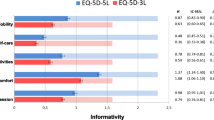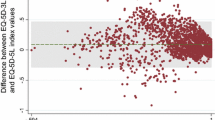Abstract
Spanish and Catalan versions of the EuroQol 5-D (EQ-5D) were included in the Catalan Health Interview Survey (CHIS) and administered to a randomly selected cross-section of 12,245 individuals from the Catalan general population. This paper analyses the feasibility, convergent validity and construct validity of three parts of the EQ-5D (the descriptive system, the visual analogue scale (VAS) and the Spanish tariff) using the results obtained in the CHIS. The feasibility was assessed by the number of missing responses. The convergent validity was based on the correlations between the EQ-5D scores and the scores on the General Health Questionnaire (GHQ) and on an index of self-perceived overall health. The construct validity was assessed by analysing the degree to which lower scores on the EQ-5D correlated positively with increasing age, being female, being in a lower social class or having a lower level of education and with increasing levels of disability, co-morbidity, restricted activity, mental health problems and poor self-perceived health. A low number of missing responses on the descriptive system and the VAS (1.5%) indicated a high level of acceptance. A marked ceiling effect was found, with 67% of the sample reporting no problem in any EQ dimension. The convergent validity with the GHQ was generally low, though moderate on the mood dimension. Self-perceived overall health correlated moderately to strongly with the mean VAS and tariff values. The positive correlations between lower scores on all three elements of the EQ-5D and increasing age, increasing levels of disability, co-morbidity, restricted activity, mental health problems and poor self-perceived health provide some evidence of the instrument's construct validity, as does the fact that women reported more problems than men. Multivariate analyses using the VAS and tariff values as dependent variables and all of the sociodemographic and health variables as independent variables reached R 2 values of 0.45 and 0.81, respectively. The Spanish and Catalan versions of the EQ-5D have proved to be feasible and valid for use in health interview surveys.
Similar content being viewed by others
References
Cella DF, Wiklund I, Shumaker SA, Aaronson NK. Integrating health-related quality of life into cross-national clinical trials. Qual Life Res 1993; 2: 433–440.
Steinwachs CM. Application of health status measures in policy research. Med Care Suppl 1989; 27: S12–S26.
Deyo RA, Inui TS. Toward clinical applications of health status measures: sensitivity of scales to clinically important changes. Health Serv Res 1984; 19: 275–289.
Patrick DL, Erickson P. Health Status and Health Policy: Quality of Life in Health Care Evaluation and Resource Allocation. New York: Oxford University Press, 1993.
Brooks R with the EuroQol Group. EuroQol: the current state of play. Health Policy 1996; 37: 53–72.
Gudex C, Dolan P, Kind P, Williams A. Health state valuations from general public using the visual analogue scale. Qual Life Res 1996; 5: 521–531.
Erens B. Health-related Quality of Life: General Population Survey. Technical Report. London: Social Community Planning Research, 1994:1–43.
Brazier J, Jones N, Kind P. Testing the validity of the EuroQol and comparing it with the SF-36 health survey questionnaire. Qual Life Res 1993; 2: 169–180.
Hurst NP, Jobanputra P, Hunter M, Lambert M, Lochhead A, Brown H. Validity of EuroQol — A generic health status instrument — in patients with rheumatoid arthritis. Br J Rheumatol 1994; 33: 655–662.
Stavem K. Quality of life in epilepsy: comparison of four utility measures. Qual Life Res 1995; 4: 489–490.
Frossard M, Jasso G, LaGabrielle D, Guyot F, Suarez C, Franco A. A comparison of four measures of the quality of life: preliminary results of the study ‘QUALIDOVIE’. Qual Life Res 1995; 4: 430.
Enquesta de Salut de Catalunya (ESCA): Document Tecnic. Barcelona: Departament de Sanitat i Seguretat Social, 1993.
Dolan P, Gudex C, Kind P, Williams A. The time trade-off method: results from a general population study. Health Econ 1996; 5: 141–154.
Rue M, Badia X. The Spanish EuroQol tariff: results from the Catalan Health Interview Survey based on self-rated health. In: Badia X, Herdman M, Segura A, eds Discussion Papers from the EuroQol Plenary Meeting. Barcelona: Catalan Institute of Public Health, 1995: 77–98.
Gudex C, Dolan P, Kind P, Williams A. Health state valuations from the general public using the visual analogue scale. Qual Life Res 1997; 5: 521–531.
Arto O, Eija Helala, Sintonen H. Modelling EuroQol values of Finnish adult population. In: Badia X, Herdman M, Segura A, eds. Discussion Papers from the EuroQol Plenary Meeting. Barcelona: Catalan Institute of Public Health, 1995: 67–76.
Badia X, Fernandez E, Segura A. Influence of socio-demographic and health status variables on evaluation of health states in a Spanish population. Eur J Public Health 1995; 5: 87–93.
Badia X, Díaz Prieto A, Rué M, Patrick DL. Measuring health and health state preferences among critically ill patients. Intens Care Med 1997; 22: 1379–1384.
Domingo A, Marcos J. Propuesta de un indicador de “clase social” basado en la ocupación. Gac Sanitaria 1989; 3(10): 320–326.
Goldberg DP. The Detection of Psychiatric Illness by Questionnaire. London: Oxford University Press, 1972.
Bergner M, Bobbitt R, Pollard WE, Martin DP, Gilson BS. The Sickness Impact Profile: validation of a health status measure. Med Care 1976; 14: 57–67.
Alonso J, Antó JM. Enquesta de Salut de Barcelona, 1986. Barcelona: Ârea de Salut Pública, Ajuntament de Barcelona, 1989.
Borrell C, Passaún I, Plasència A. Enquesta de Salut de Barcelona 1992–1993. Estadístiques de Salut No. 23. Barcelona: Ajuntament de Barcelona, 1995.
Encuesta Nacional de Salud 1993. Madrid: Ministerio de Sanidad y Consumo, 1995.
Netherlands Central Bureau of Statistics and Erasmus University. International Variation in Socio-economic Inequalities of Self-reported Health. Voorburg: Netherlands Central Bureau of Statistics, 1992.
Hosmer DW, Lemeshow S. Applied Logistic Regression. New York: John Wiley & Sons, 1987.
Kleinbaum DG, Kupper LL, Muller KE. Applied Regression Analysis and Other Multivariable Methods. Belmont: Duxbury Press, 1987.
Kind P, Gudex C, Dolan P, Williams A. Sociodemographic variations in self-rated quality of life. Qual Life Res 1995; 4: 446–447.
Kind P. Weighting life expectancy for quality — whose values count? Qual Life Res 1995; 4: 447–448.
Hays RD, Anderson R, Revicki DA. Psychometric evaluation and interpretation of health-related quality of life data. In: Shumaker SA, Berzon R, eds. The International Assessment of Health-related Quality of Life: Theory, Translation, Measurement and Analysis. Oxford, New York: Rapid Communications, 1995. pp. 103–114.
EuroQol Group. EuroQol — a new facility for the measurement of health-related quality of life. Health Policy 1990; 16: 199–208.
Furlong W, Feeny D, Boyle M, Torrance GW. Multiattribute health status classification systems. Health Utilities Index. PharmacoEconomics 1995; 7: 490–502.
Dupuy HJ. The psychological general well-being (PGWB) index. In: Wergner NK, Mattson ME, Fuberg CP, eds. Assessment of Quality of Life in Clinical Trials of Cardiovascular Therapies. New York: Le Jacq, 1984. pp. 170–183.
Author information
Authors and Affiliations
Rights and permissions
About this article
Cite this article
Badia, X., Schiaffino, A., Alonso, J. et al. Using the EuroQol 5-D in the Catalan General Population: Feasibility and Construct Validity. Qual Life Res 7, 311–322 (1998). https://doi.org/10.1023/A:1024933913698
Issue Date:
DOI: https://doi.org/10.1023/A:1024933913698




